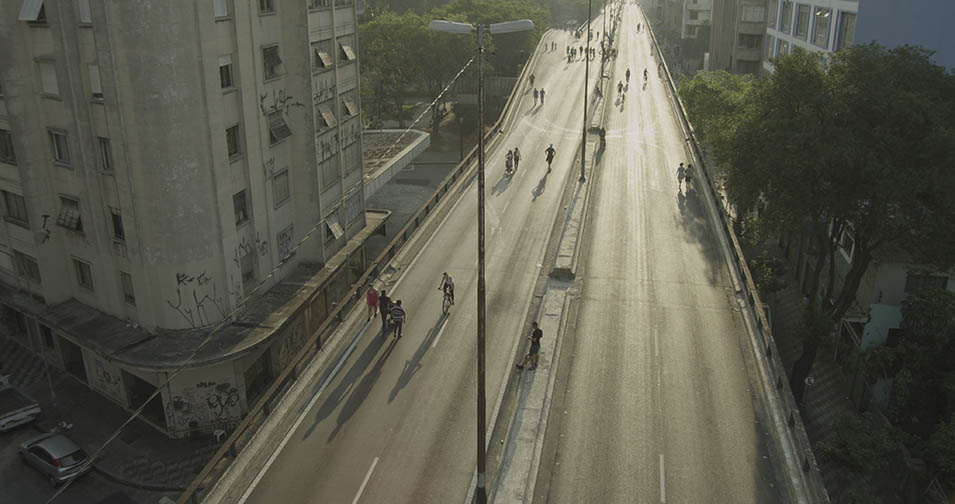 |
| Mark Lewis, Above and Below the Minhocao, 2014 |
Being so underwhelmed by the recent installation of Lewis’ films at the Louvre, I was relieved to see that the in situ installation
of some of his new works at Le Bal in the 17th arrondissment was done
with more care and respect for the integrity of the films. For all the reasons
the film installations did not work at the Louvre, Above and Below does. At Le Bal, the 35mm and HD works are
exhibited in spaces where people can uninterruptedly watch them in comfort, see
the clarity of the image, and experience their physical response. The interest
in Lewis’ films is often the physical experience of watching a camera very
slowly moving across and around a space uninterruptedly, creating a smooth path
through impossible angles and perspectives. Most often, we experience nausea,
dizziness, the unsettling experience of being taken on a journey only to end up
back where it began, and having to ask, how did I get here? And in order to
have this experience, the projection and viewing conditions need to be very
precisely observed.
 |
| Mark Lewis, Hendon FC, 2009 |
While Lewis is known to work with and
manipulate the materials of film, often engaging with histories of visual
representation, these on exhibition at Le Bal seemed like a shift into more
political territory than others that I have seen previously. Above and Below the Minhocao, 2014, the
work that gives the exhibition its title, is a complex and detailed film that
demonstrates this venture into the political. The moving bird’s eye views of
the great auto route in Sao Paulo on a weekend afternoon is unsettling simply
because of the absence of cars and the odd sense of decay and nostalgia,
emphasized by the late afternoon sun. With the traffic nowhere to be seen and
the long lazy shadows of bikers and runners, enjoying the freedom to run and
bike along this uninterrupted stretch of highway, the contradictions are
everywhere in tension along this monument to modernity. Apparently, 80,000 cars
traverse the Minhocao per day, but in Lewis’ film, there are none. Below the
overpass, the streets are old and worn, the houses not so up to date, there’s a
tiredness and a sense of the forgotten about this apparent revolutionary
structure. Lewis’ familiar slow motion tracking and focus pulling from an
airborne camera underlines the laziness of the day: the camera takes us
nowhere, it becomes as langorous as the people out enjoying the last vestiges
of sun.
 |
| Mark Lewis, Forte, 2010 |
Like Forte,2010, also on exhibition here, Hendon FC,
2009, is also disorienting. A camera takes us around an abandoned football
ground taken over by Roma Gypsies. The
film is unsettling because the camera ends up sweeping through the overgrown
grass and we become lost, with it, in the overgrowth. This, even as the film is
also a mapping of the space and the daily lives lived there by the Roma
families.
 |
| Mark Lewis, Cold Morning, 2009 |
Another work that forces a discomfort of a
different kind is Cold morning
(2009). Through a fixed camera, a homeless person whose face we never see
organizes his or her clothes and other possessions on the street. The figure
meticulously works across the 8 minute film next to an underground steam hole
while the odd figure passes by, two pigeons watch for a while. What is most
striking about the person’s actions is how strong the identification is: the
ordering and reordering of possessions is something I find myself doing, everyday.
Cold Morning speaks to the
circularity of life, the mindless routines and rituals we engage in, rituals
that are the great equalizer among us. This is the preservation of life that we
are all involved in, and this makes the images unsettling: it is as if the camera
is turned on us as the subjects of this film.
Lastly, Le Bal is one of a number of interesting
spaces recently opened in Paris that have taken over disused spaces for the
exhibition of art. It’s a great place to visit as not only do they have great
exhibitions and talks, there’s an excellent bookstore and of course, because
it’s Paris, a café.
All images courtesy Mark Lewis Studio
No comments:
Post a Comment